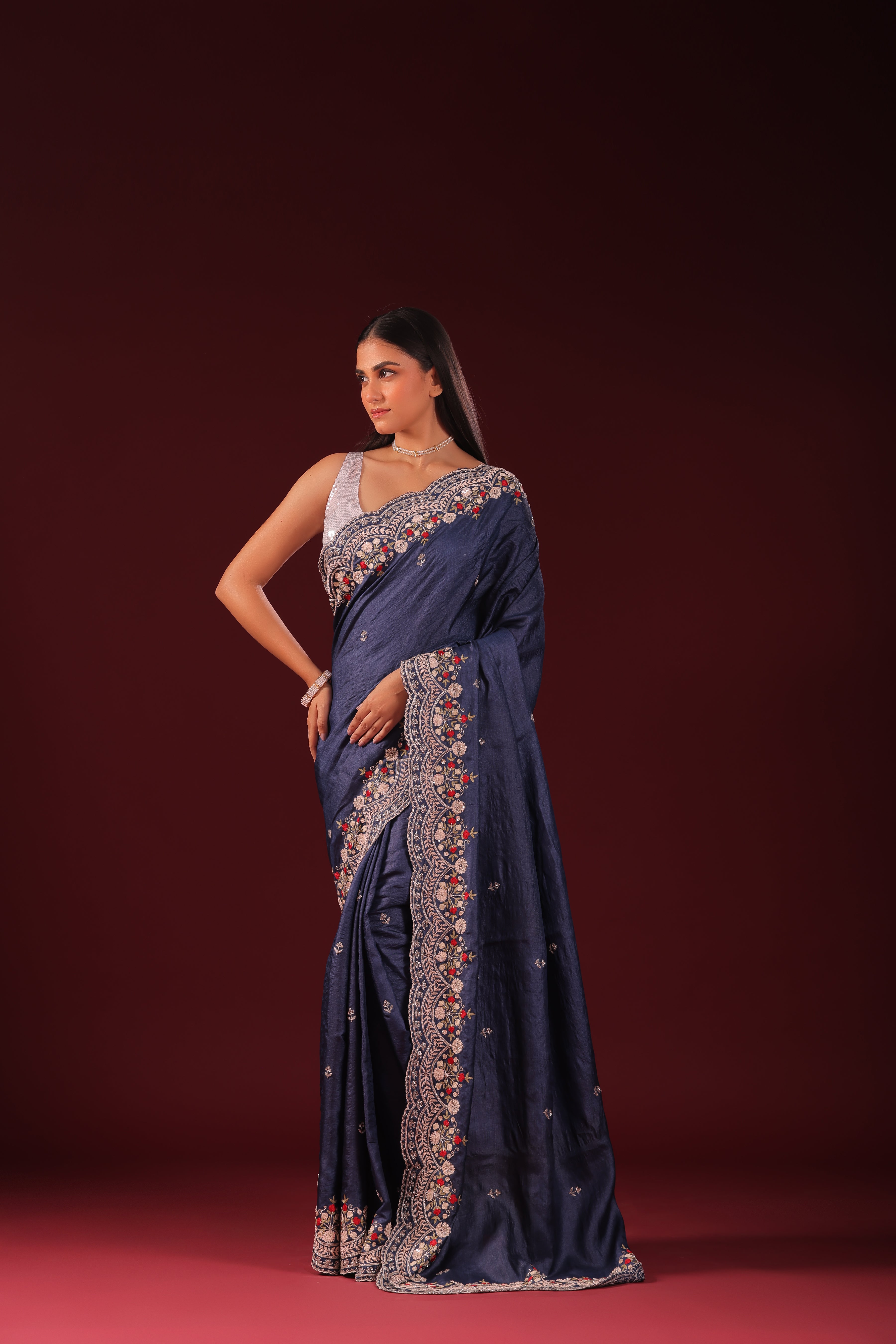Tussar Zardozi Work is a type of traditional hand embroidery that combines Tussar silk fabric with Zardozi embroidery techniques, resulting in intricate, luxurious designs. Zardozi is a centuries-old embroidery style that originated in Persia but became deeply rooted in Indian textiles. It uses metallic threads like gold, silver, or copper to create ornamental, raised patterns, often on fine fabrics like Tussar silk.
Key Features of Tussar Zardozi Work:
-
Fabric: Tussar Silk
-
Tussar Silk, also known as Kosa silk, is a natural, unrefined silk produced by wild silkworms, primarily in regions of India like Bihar, Odisha, and West Bengal.
- Tussar silk has a textured, coarse feel compared to other silks and is typically golden or brown in color, giving it a rich and earthy appearance. This natural beauty provides a stunning backdrop for Zardozi embroidery.
- The slightly rough texture of Tussar silk allows the metallic threads used in Zardozi embroidery to stand out beautifully, creating a dramatic contrast.
-
Embroidery Technique: Zardozi
-
Zardozi is a form of metallic thread embroidery, where threads of gold, silver, or copper are used to create intricate, raised patterns. This technique is highly valued for its richness and is often used in bridal wear, ceremonial garments, and luxury fashion.
- Zardozi work involves various stitches like chain stitch, stem stitch, French knot, and knot stitch, with each design being hand-embroidered onto the fabric with a needle and metallic thread.
- The gold and silver threads give the embroidery a regal, shimmering effect, making it ideal for special occasions like weddings and festivals.
-
Designs and Motifs:
- The designs in Tussar Zardozi work often feature a blend of traditional and modern motifs, such as floral patterns, paisleys, peacocks, vines, mandalas, and geometric shapes.
- The motifs are usually dense, filling the entire fabric or appearing on borders and the pallu (the end piece of a saree).
- Embellishments like beads, sequins, pearls, and stones are often added to further elevate the embroidery's luxury and detail.
-
Colors:
- Tussar silk usually comes in shades of golden, beige, brown, or natural earth tones, creating a warm, luxurious base.
- The metallic threads in Zardozi work are typically gold, silver, or copper, though some contemporary designs may incorporate a variety of colorful threads to create a more vibrant look.
- The combination of the natural hues of Tussar silk with the lustrous metallic threads of Zardozi creates a striking contrast that enhances the embroidery's visual impact.
-
Occasions:
-
Tussar Zardozi work is most commonly used for high-end fashion, especially in bridal wear, evening gowns, lehengas, sarees, and suits. The luxurious nature of the embroidery makes it perfect for weddings, parties, and other formal events.
- Due to its rich appearance, these garments are often worn on special occasions when one wants to make a bold, elegant statement.
-
Care:
-
Tussar silk and Zardozi embroidery are delicate and require careful handling. These garments should be dry-cleaned to preserve both the fabric and the intricate embroidery.
- For long-term storage, it is advisable to keep them in a cool, dry place, away from direct sunlight, to prevent fading and damage to the metallic threads.
Why Tussar Zardozi Work is Popular:
-
Rich Texture: The natural texture of Tussar silk gives the fabric a sophisticated feel, making it ideal for the high-drama effect of Zardozi.
-
Luxurious Appeal: The combination of fine silk and metallic threads makes Tussar Zardozi work perfect for those seeking a high-end, opulent look.
-
Traditional Craftsmanship: Zardozi embroidery is a time-honored technique, and when combined with the rustic beauty of Tussar silk, it brings together the best of Indian craftsmanship and culture.
Tussar Zardozi work beautifully blends the luxurious appeal of silk with the rich, ornamental quality of metallic embroidery, making it one of the most sought-after and exquisite fabric embellishment techniques in the world of fashion and bridal wear.














